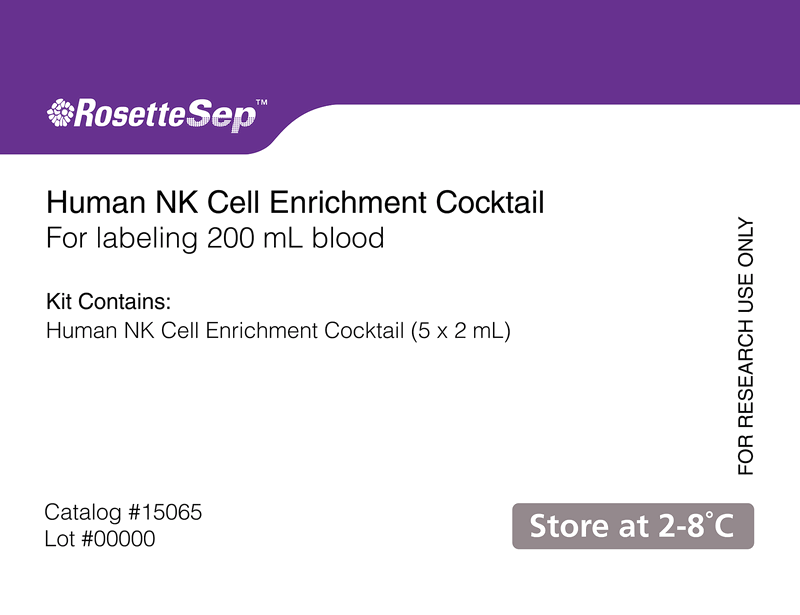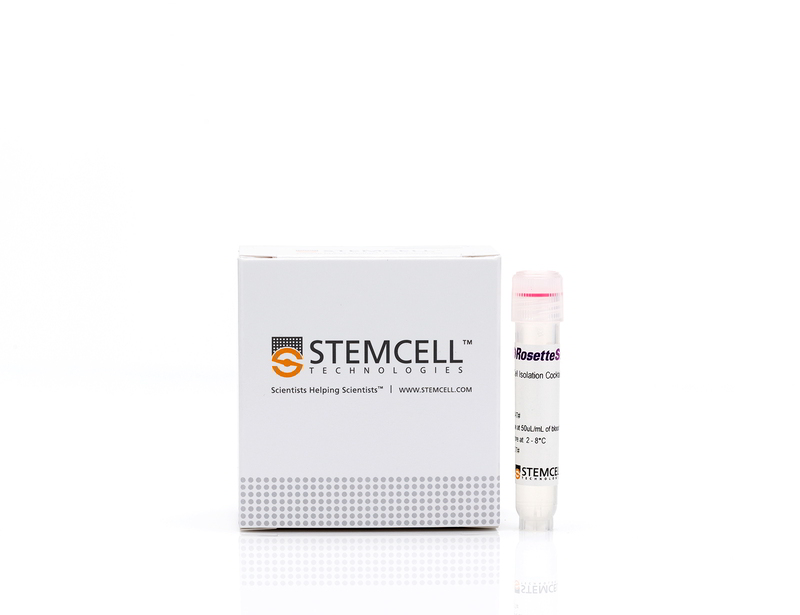RosetteSep™ Human NK Cell Enrichment Cocktail
Immunodensity negative selection cocktail
概要
The RosetteSep™ Human NK Cell Enrichment Cocktail is designed to isolate NK cells from whole blood by negative selection. Unwanted cells are targeted for removal with Tetrameric Antibody Complexes recognizing non-NK cells and red blood cells (RBCs). When centrifuged over a buoyant density medium such as RosetteSep™ DM-L (Catalog #15705) or Lymphoprep™ (Catalog #07801), the unwanted cells pellet along with the RBCs. The purified NK cells are present as a highly enriched population at the interface between the plasma and the buoyant density medium.
Advantages
• Fast and easy-to-use
• Requires no special equipment or training
• Isolated cells are untouched
• Can be combined with SepMate™ for consistent, high-throughput sample processing
• Requires no special equipment or training
• Isolated cells are untouched
• Can be combined with SepMate™ for consistent, high-throughput sample processing
Components
- RosetteSep™ Human NK Cell Enrichment Cocktail (Catalog #15025)
- RosetteSep™ Human NK Cell Enrichment Cocktail, 2 mL
- RosetteSep™ Human NK Cell Enrichment Cocktail (Catalog #15065)
- RosetteSep™ Human NK Cell Enrichment Cocktail, 5 x 2 mL
Subtype
Cell Isolation Kits
Cell Type
NK Cells
Species
Human
Sample Source
Buffy Coat, Whole Blood
Selection Method
Negative
Application
Cell Isolation
Brand
RosetteSep
Area of Interest
Immunology
技术资料
| Document Type | 产品名称 | Catalog # | Lot # | 语言 |
|---|---|---|---|---|
| Product Information Sheet | RosetteSep™ Human NK Cell Enrichment Cocktail | 15025, 15065 | All | English |
| Safety Data Sheet | RosetteSep™ Human NK Cell Enrichment Cocktail | 15025, 15065 | All | English |
数据及文献
Data

Figure 1. FACS Histogram Results Using RosetteSep™ Human NK Cell Enrichment Cocktail
Starting with fresh peripheral blood the CD56+ cell content of the enriched fraction typically ranges from 80 - 98%. *Note: Red blood cells were removed by lysis prior to flow cytometry.
Publications (52)
Nature 2020
Single-shot Ad26 vaccine protects against SARS-CoV-2 in rhesus macaques.
Abstract
Abstract
A safe and effective vaccine for severe acute respiratory syndrome coronavirus 2 (SARS-CoV-2) may be required to end the coronavirus disease 2019 (COVID-19) pandemic1-8. For global deployment and pandemic control, a vaccine that requires only a single immunization would be optimal. Here we show the immunogenicity and protective efficacy of a single dose of adenovirus serotype 26 (Ad26) vector-based vaccines expressing the SARS-CoV-2 spike (S) protein in non-human primates. Fifty-two rhesus macaques (Macaca mulatta) were immunized with Ad26 vectors that encoded S variants or sham control, and then challenged with SARS-CoV-2 by the intranasal and intratracheal routes9,10. The optimal Ad26 vaccine induced robust neutralizing antibody responses and provided complete or near-complete protection in bronchoalveolar lavage and nasal swabs after SARS-CoV-2 challenge. Titres of vaccine-elicited neutralizing antibodies correlated with protective efficacy, suggesting an immune correlate of protection. These data demonstrate robust single-shot vaccine protection against SARS-CoV-2 in non-human primates. The optimal Ad26 vector-based vaccine for SARS-CoV-2, termed Ad26.COV2.S, is currently being evaluated in clinical trials.
Scientific reports 2019 mar
Soy isoflavones and their metabolites modulate cytokine-induced natural killer cell function.
Abstract
Abstract
Soybeans are a rich source of isoflavones that have been linked with anti-inflammatory processes and various health benefits. However, specific mechanisms whereby soy bioactives impact immune cell subsets are unclear. Isoflavones, such as genistein and daidzein, are metabolized by microbes to bioactive metabolites as O-desmethylangolensin (O-DMA) and equol, whose presence has been linked to health benefits. We examined how soy isoflavones and metabolites impact natural killer (NK) cell signaling and function. We observe no impact of isoflavones on viability of healthy donor peripheral blood mononuclear cells (PBMCs) or NK cells, even at high (25 µM) concentrations. However, pre-treatment of PBMCs with physiologically-relevant concentrations of genistein (p = 0.0023) and equol (p = 0.006) decreases interleukin (IL)-12/IL-18-induced interferon-gamma (IFN-gamma) production versus controls. Detailed cellular analyses indicate genistein and equol decrease IL-12/IL-18-induced IFN-gamma production by human NK cell subsets, but do not consistently alter cytotoxicity. At the level of signal transduction, genistein decreases IL-12/IL-18-induced total phosphorylated tyrosine, and phosphorylation MAPK pathway components. Further, genistein limits IL-12/IL-18-mediated upregulation of IL-18Ralpha expression on NK cells (p = 0.0109). Finally, in vivo studies revealed that C57BL/6 mice fed a soy-enriched diet produce less plasma IFN-gamma following administration of IL-12/IL-18 versus control-fed animals (p {\textless} 0.0001). This study provides insight into how dietary soy modulates NK cell functions.
The Journal of clinical investigation 2019 dec
Selective induction of antibody effector functional responses using MF59-adjuvanted vaccination.
Abstract
Abstract
Seasonal and pandemic influenza infection remains a major public health concern worldwide. Driving robust humoral immunity has been a challenge given preexisting, often cross-reactive, immunity and in particular, poorly immunogenic avian antigens. To overcome immune barriers, the adjuvant MF59 has been used in seasonal influenza vaccines to increase antibody titers and improve neutralizing activity, translating to a moderate increase in protection in vulnerable populations. However, its effects on stimulating antibody effector functions, including NK cell activation, monocyte phagocytosis, and complement activity, all of which have been implicated in protection against influenza, have yet to be defined. Using systems serology, we assessed changes in antibody functional profiles in individuals who received H5N1 avian influenza vaccine administered with MF59, with alum, or delivered unadjuvanted. MF59 elicited antibody responses that stimulated robust neutrophil phagocytosis and complement activity. Conversely, vaccination with MF59 recruited NK cells poorly and drove moderate monocyte phagocytic activity, both likely compromised because of the induction of antibodies that did not bind FCGR3A. Collectively, defining the humoral antibody functions induced by distinct adjuvants may provide a path to designing next-generation vaccines that can selectively leverage the humoral immune functions, beyond binding and neutralization, resulting in better protection from infection.
Nature medicine 2019
IFN-gamma-independent immune markers of Mycobacterium tuberculosis exposure.
Abstract
Abstract
Exposure to Mycobacterium tuberculosis (Mtb) results in heterogeneous clinical outcomes including primary progressive tuberculosis and latent Mtb infection (LTBI). Mtb infection is identified using the tuberculin skin test and interferon-gamma (IFN-gamma) release assay IGRA, and a positive result may prompt chemoprophylaxis to prevent progression to tuberculosis. In the present study, we report on a cohort of Ugandan individuals who were household contacts of patients with TB. These individuals were highly exposed to Mtb but tested negative disease by IFN-gamma release assay and tuberculin skin test, 'resisting' development of classic LTBI. We show that 'resisters' possess IgM, class-switched IgG antibody responses and non-IFN-gamma T cell responses to the Mtb-specific proteins ESAT6 and CFP10, immunologic evidence of exposure to Mtb. Compared to subjects with classic LTBI, 'resisters' display enhanced antibody avidity and distinct Mtb-specific IgG Fc profiles. These data reveal a distinctive adaptive immune profile among Mtb-exposed subjects, supporting an expanded definition of the host response to Mtb exposure, with implications for public health and the design of clinical trials.
Cancer research 2017 NOV
Tethering IL2 to Its Receptor IL2Rβ Enhances Antitumor Activity and Expansion of Natural Killer NK92 Cells.
Abstract
Abstract
IL2 is an immunostimulatory cytokine for key immune cells including T cells and natural killer (NK) cells. Systemic IL2 supplementation could enhance NK-mediated immunity in a variety of diseases ranging from neoplasms to viral infection. However, its systemic use is restricted by its serious side effects and limited efficacy due to activation of T regulatory cells (Tregs). IL2 signaling is mediated through interactions with a multi-subunit receptor complex containing IL2Rα, IL2Rβ, and IL2Rγ. Adult natural killer (NK) cells express only IL2Rβ and IL2Rγ subunits and are therefore relatively insensitive to IL2. To overcome these limitations, we created a novel chimeric IL2-IL2Rβ fusion protein of IL2 and its receptor IL2Rβ joined via a peptide linker (CIRB). NK92 cells expressing CIRB (NK92CIRB) were highly activated and expanded indefinitely without exogenous IL2. When compared with an IL2-secreting NK92 cell line, NK92CIRB were more activated, cytotoxic, and resistant to growth inhibition. Direct contact with cancer cells enhanced the cytotoxic character of NK92CIRB cells, which displayed superior in vivo antitumor effects in mice. Overall, our results showed how tethering IL2 to its receptor IL2Rβ eliminates the need for IL2Rα and IL2Rβ, offering a new tool to selectively activate and empower immune therapy. Cancer Res; 77(21); 5938-51. textcopyright2017 AACR.
Cell 2016 SEP
A Functional Role for Antibodies in Tuberculosis.
Abstract
Abstract
While a third of the world carries the burden of tuberculosis, disease control has been hindered by a lack of tools, including a rapid, point-of-care diagnostic and a protective vaccine. In many infectious diseases, antibodies (Abs) are powerful biomarkers and important immune mediators. However, in Mycobacterium tuberculosis (Mtb) infection, a discriminatory or protective role for humoral immunity remains unclear. Using an unbiased antibody profiling approach, we show that individuals with latent tuberculosis infection (Ltb) and active tuberculosis disease (Atb) have distinct Mtb-specific humoral responses, such that Ltb infection is associated with unique Ab Fc functional profiles, selective binding to FcγRIII, and distinct Ab glycosylation patterns. Moreover, compared to Abs from Atb, Abs from Ltb drove enhanced phagolysosomal maturation, inflammasome activation, and, most importantly, macrophage killing of intracellular Mtb. Combined, these data point to a potential role for Fc-mediated Ab effector functions, tuned via differential glycosylation, in Mtb control.




